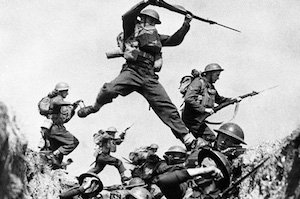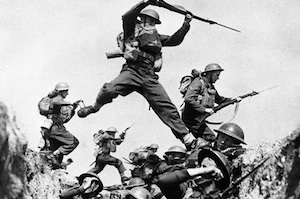
A full century after World War I we still cannot understand how generals sent so many soldiers to be slaughtered. Ten million soldiers died on all sides; millions more were left maimed or shell shocked. Seven million civilians died. 20 million horses died.
The image we have of hapless soldiers being forced to climb out of their sodden trenches and attack across a hellish no-man’s land pock-marked by water-filled shell holes, deep mud, thickets of barbed wire and rotten bodies is quite accurate for the Western Front. Waiting for them were quick-firing guns, heavy artillery, the greatest killer or all – machine guns – and, later, poison or burning gases, and flamethrowers.
How could the generals of that era have been stupid enough to send waves and waves of their soldiers to almost certain death? Trench warfare in the West quickly became siege warfare in which decisive victories became almost impossible.
Only in the East did the brilliant German generals Hindenburg and Max Hoffman achieve a war of movement in which they destroyed two Russian armies attacking East Prussia. Their triumphant battles at Tannenburg and Masurian Lakes were partly based on Hannibal’s battlefield tactics at Cannae in 216 BC.
But on the Western Front, generals on all sides kept sending their men on suicidal bayonet charges across dense wire in the face of interlocking machine gun fire and shrapnel. How could they have been so foolish?
As a former instructor in military history, permit me some thoughts: most of the British, French, Belgian, Russian and many of the Italian generals had learned their profession fighting colonial wars in Africa and Asia against native levies armed only with spears and swords. They were, no surprise, wholly untrained for modern warfare against European soldiers. If the US Army, trained for colonial warfare against lightly armed enemies, ever has to fight China or Russia, it will encounter the same nasty problem.
Next, most of the generals poorly understood the power of massed rifle or artillery fire. There was no excuse for this: the British has always been renowned for their iron discipline and ability to pour massive fire into advancing enemies – a skill that won them the Battle of Waterloo. Fighting Afghans, Berber tribesmen, and Zulu dulled these skills.
And even less excuse for fatally ignoring the vitally important of lessons from the first bloody, modern conflict of the 20th Century – the 1904-05 Russo-Japanese War. This war, fought on China’s Liaotung Peninsula and Manchuria, was the first modern war, a harbinger for the coming slaughter in the rest of the century.
Ironically, though this big war was covered by very experienced war correspondents and military attachés from many nations, the dire message of the war was ignored by Western military establishments.
The 1904-05 war saw the first intensive use of machine guns, barbed wire, hand grenades, body armor, searchlights, poison gas, and concentrated fire of field and heavy guns against tightly packed enemy infantry. But few took notice. The US Navy failed to remember that the 1904 war was opened by a surprise Japanese attack on the key Russian naval base at Port Arthur. Or that courage and drive – what French called “elan vital” – were not enough to carry heavily defended positions.
What was learned was that forts were important even though guns on their parapets could not survive. That medical services had to be beefed up. And that logistics was a key component of modern warfare
Generals on the Western front ran into the same problem the Japanese did in Manchuria: they never had enough men to envelop an enemy and cut off his retreat. A capable enemy would simply retreat to avoid encirclement. Not until fluid, fast-moving German Panzer tactics of 1940 would this problem be solved.
Forts, which are now considered useless military relics, assumed a prime role, first in the defense of the Belgian cities of Liege and Namur. Then more so at the Armageddon battle at Verdun where a million soldiers died on both sides in a tiny area of hell. Forts Douaumont and Vaux became the epicenter of the savage battle for Verdun. At one point, 2,000 heavy shells were landing each hour atop Vaux.
After WWI, France decided to build a powerful line of forts – the Maginot Line – to help defend parts of its frontiers. By contrast, Germany opted for a war of movement, or blitzkrieg, to avoid ever becoming bogged down in siege warfare.
Reprinted with author’s permission.

